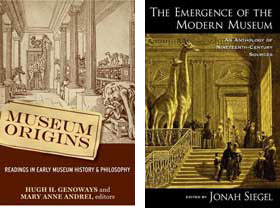The emergence of the modern museum: An anthology of nineteenth century sources
by Jonah Seigel, Oxford University Press, New York, 2008
ISBN: 978 019533 1134, RRP A$39.95
Museum origins: Readings in early museum history and philosophy
by Hugh H Genoways and Mary Anne Andrei, Left Coast Press, Walnut Creek, California, 2008
ISBN: 978 159874 1971, RRP A$34.95
review by Ian Coates

Throughout their history 'museums' have existed as a diverse set of practices, institutions and motivations that defy a simple universal definition. Common to most, however, has been an ambition to collect, classify, contextualise and historicise different aspects of the material world. Given this, it is perhaps unsurprising that museum practitioners and historians regularly produce works which collect and analyse the histories and origins of 'modern' museums. Seigel's Emergence and Genoways' and Andrei's Origins offer two recent collections, drawing principally on primary source material from a diverse range of authors, from the late nineteenth and early twentieth centuries, the so called 'museum period'.
The two collections cover a diversity of topics, many of which are of continuing relevance to contemporary museums. These include the move from private collections to public institutions (Emergence), the classification, definition and organisation of both objects and the museums in which they are held, the public and policy debates which occurred around the decisions behind these classifications and typologies, and the relationship between regional museums and those in the metropolitan centres.
Implicit within Origins is a broad definition of what constitutes a museum, with pieces ranging across natural history museums, house museums, art galleries, war memorials. It also contains numerous papers about natural history, including papers on botanic and zoological gardens. This perhaps in part reflects the editors' background in the natural sciences and the history of science. While Emergence has a more restricted focus, it includes perspectives on the influence of archaeological and anthropological material on museums and also touches on the links between colonialism and museums, through two papers about the representation of India in London museums. The two collections converge in their reflections on the development of both British and American museums as pedagogical institutions.
It is a testament to the diversity of contemporary thinking about museums that these two anthologies can offer such different readings of museum history. Although both are the product of American scholars, they explore very different worlds of museums. Emergence focuses exclusively on British publications and institutions; indeed it would perhaps be more appropriately titled 'the emergence of the modern museum in Britain'. By contrast, although having an American emphasis, Origins is more international in scope, including pieces from the United States, Britain, Canada and Australia.
Such works have the capacity to cut through the rhetoric around events that have been influential in our understandings of the past, such as the role of the Elgin Marbles in the British Museum, or the relationship between national (the South Kensington — now the Victoria and Albert museum) and provincial museums.
Examination of the minutiae of public debate about these issues reveals the complexity of arguments around events that we now gloss over. It provides us with something of the flavour of the differing viewpoints in the past, as well as demonstrating the centrality of such museum issues in the media and political thinking of the day. This is particularly the case in Emergence, which makes much use of parliamentary debate and reports.
Each collection adopts the approach of extracting salient pieces from longer source documents. There is a fine line here — on the one hand it makes material accessible which would otherwise be unlikely to be read; on the other, there is a risk of losing the complexity of the original author's arguments. The quality of the linking narration in both collections addresses this issue well.
With such anthologies the discoverability of the information contained within is also essential. In this regard both collections are well indexed and include useful notes on the quoted authors. Emergence also includes a glossary of collectors and collections, and suggested further readings.
While I enjoyed both Origins and Emergence, a number of absences struck me. The first was the absence of material relating to a history of social history museums, by which I mean those institutions that attempt to reflect the contemporary society within which they are embedded. The second was the absence of material reflecting the development of museums outside the United Kingdom and the United States. Only Origins includes any Australian content — Gerard Krefft's 1869 paper to the Royal Society of New South Wales in which he discusses the usefulness of applying the British Museum's exhibition techniques for the display of natural history material in Australia. Apart from this and material in Emergence about the display of India in the United Kingdom, the dynamics of museums at the edges of the colonial enterprise, be that in India, Africa, Asia or Australasia, remain largely unexplored.
This led me to consider the relevance of these works for understanding the history of Australian museums and, further, to pine for a similar compilation of Australian writings — one in which the museological writings of early museum pioneers such as Frederick McCoy, Baldwin Spencer, EC Stirling and Robert Etheridge are brought to light in identifying an Australian tradition of museological thought.
Overall, however, I was struck by how relevant much of the material contained in both collections continues to be, with the same fundamental issues, such as collections, audiences, exhibition culture and interpretation, continuing to inform contemporary museological debates. In this regard, both Origins and Emergence are useful additions to the growing literature on the history of museums.
Ian Coates is a senior curator in the Aboriginal and Torres Strait Islander program at the National Museum of Australia.
